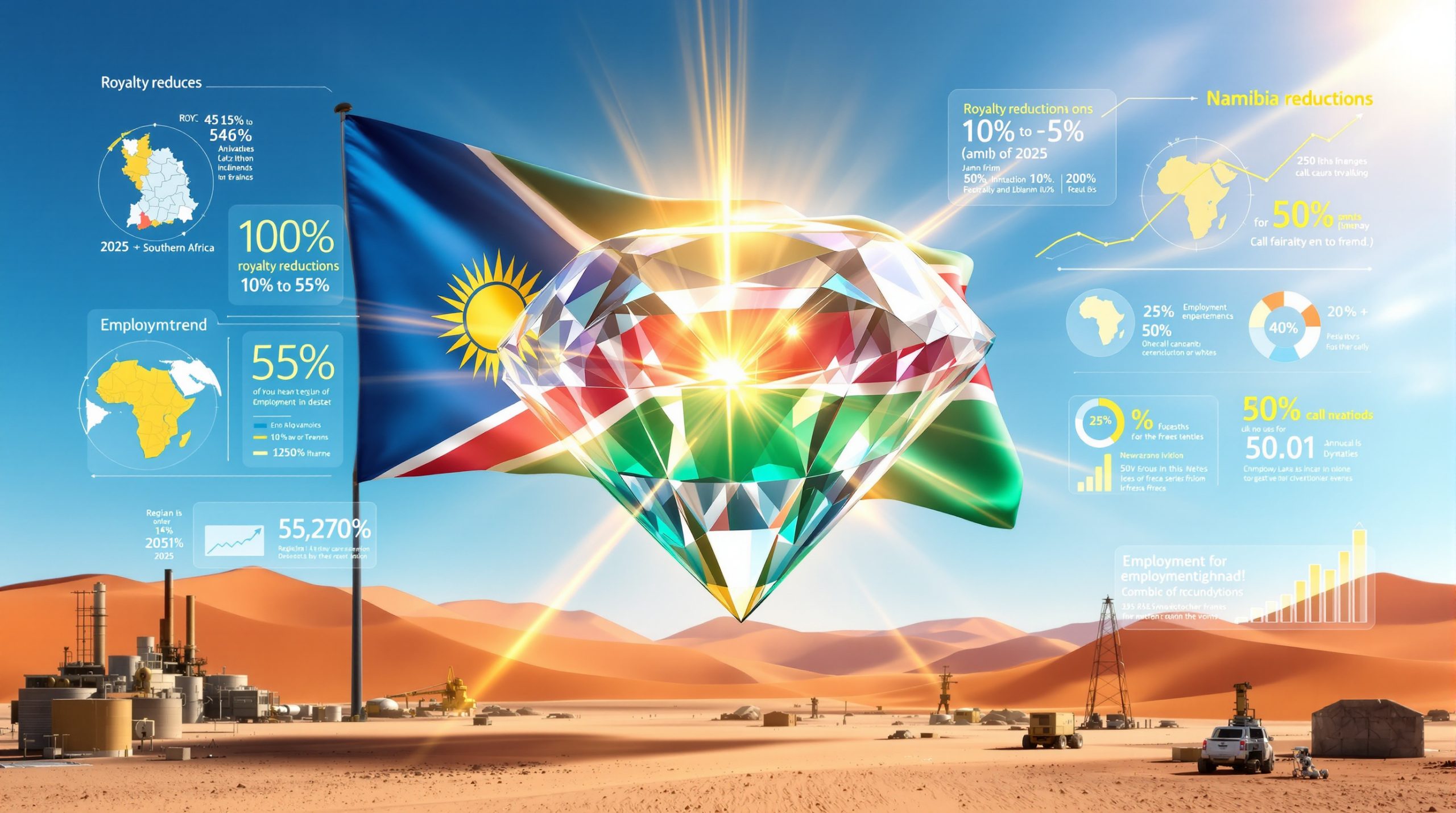How African Nations Are Reshaping Global Diamond Ownership
The diamond industry finds itself at a crucial turning point as Botswana and Angola pursue distinctly different strategies to increase their stakes in De Beers, the iconic diamond company. This strategic maneuvering represents more than corporate ownership changes—it reflects a fundamental shift in how resource-rich nations are asserting control over their natural wealth and seeking to reshape the global mining landscape on the world stage.
De Beers, valued at approximately $5 billion according to Anglo American's assessments, remains one of the world's most influential diamond enterprises. Currently, Anglo American holds 85% ownership, while the Government of Botswana maintains a 15% stake—a structure that has defined the company's operations for years but now faces significant pressure for transformation.
Why Is Botswana Seeking Greater Control of De Beers?
Botswana's Diamond-Dependent Economy
Botswana's pursuit of increased ownership stems from its profound economic reliance on diamonds. The precious stones account for approximately:
- 30% of the country's GDP
- 80% of export earnings
- A significant portion of government revenue
This dependency creates both opportunity and vulnerability, driving Botswana's leadership to seek greater control over the resource that underpins its national prosperity.
President Boko's Sovereignty Vision
President Duma Boko has framed Botswana's bid for De Beers as a matter of economic sovereignty. His administration aims to:
- Secure a controlling stake exceeding 50% ownership
- Leverage international partnerships for financing
- Transform Botswana from a resource provider to a market controller
The president's approach represents a significant departure from historical arrangements, positioning Botswana to potentially dictate terms in an industry where it has traditionally been a junior partner despite its outsized production contribution.
The Extraordinary Profit-Sharing Arrangement
Diamond expert Martyn Marriott highlights that Botswana currently enjoys an unprecedented profit-sharing arrangement with De Beers, with:
- 80% of mine profits flowing directly to Botswana
- A level of resource revenue capture that exceeds global mining industry norms
This raises questions about whether pursuing majority ownership might risk disrupting an already favorable economic arrangement. According to Anglo American draws Botswana into $5B De Beers sale talks, the current deal "far surpasses anything in the mining industry anywhere in the world."
What Is Angola's Alternative Vision for De Beers?
Angola's Pan-African Consortium Approach
In contrast to Botswana's control-focused strategy, Angola has proposed:
- A fully financed bid for a strategic minority stake
- Formation of a pan-African diamond producers' consortium
- Inclusion of other diamond nations like Namibia and South Africa
- Maintaining De Beers as a private-sector-led global enterprise
This approach emphasizes collaborative governance rather than single-nation dominance, reflecting Angola's view that the diamond industry benefits from distributed influence.
Angola's Growing Diamond Sector
Angola's interest isn't merely philosophical—it's backed by significant industry presence:
- Rapidly increasing diamond production volumes
- Major investments in mining infrastructure
- Ambitions to become a top-five global diamond producer
These factors give Angola both the financial capability and strategic motivation to pursue a meaningful stake in De Beers.
Preventing Single-Nation Dominance
A central tenet of Angola's proposal is ensuring that:
- No single country controls De Beers' future
- The company maintains its global competitiveness
- African producing nations collectively benefit from the industry's success
This approach directly challenges Botswana's majority-control ambitions, creating tension between the two diamond-producing nations.
How Might These Competing Visions Impact the Diamond Industry?
Potential Return to Market Discipline
Marriott suggests that the current ownership debate presents an opportunity to restore discipline to the natural diamond market through:
- Potential revival of stockpile management
- Implementation of production quotas to balance supply and demand
- Renewed focus on collective marketing initiatives
- Collaborative approaches similar to the former Central Selling Organisation
These historical industry practices helped maintain diamond value and market stability before the fragmentation of the 1980s and 1990s.
The Collaboration vs. Fragmentation Dilemma
The diamond industry faces a fundamental choice:
- Return to collaborative models that historically supported price stability
- Continue the fragmentation that has characterized recent decades
- Navigate new challenges from synthetic diamonds and changing consumer preferences
Marriott's analysis suggests that "collaboration is what gave diamonds their old strength; fragmentation is what has created their current weakness."
Lessons from Historical Diamond Market Management
The industry's history offers valuable lessons:
- The Central Selling Organisation's role in balancing supply and demand
- Successful absorption of West African alluvial diamond production
- The "Diamonds are Forever" campaign's impact on consumer perception
- Russia's recognition of collective benefit from coordinated marketing
These historical examples demonstrate how structured collaboration benefited all participants in the diamond value chain.
What Are the Potential Outcomes of This Ownership Struggle?
Diplomatic Tensions and Negotiations
The competing visions have reportedly created diplomatic friction between Botswana and Angola, with:
- Ongoing negotiations between the nations
- Potential mediation by other African diamond producers
- Anglo American's strategic considerations as the current majority owner
The resolution of these tensions will shape not just company ownership but the future direction of the global diamond industry.
Economic Implications for Producer Nations
The stakes for diamond-producing countries extend beyond corporate control to include:
- Revenue distribution across the value chain
- Employment opportunities in mining and processing
- Economic diversification potential
- Long-term sustainability planning as diamond reserves evolve
These considerations make the ownership question a matter of national economic security for the countries involved.
Market Structure and Pricing Power
The industry's future pricing power and market structure hang in the balance:
- Will a return to more coordinated supply management emerge?
- Can natural diamonds maintain premium positioning against synthetics?
- How will consumer markets respond to changing industry ownership?
- What role will marketing play in sustaining diamond value?
The answers to these questions will determine whether diamonds retain their historical mystique and value in coming decades.
What Does This Mean for the Future of African Resource Sovereignty?
A Template for Resource Nationalism
The De Beers ownership struggle represents a potential template for how resource-rich nations might:
- Assert greater control over their natural endowments
- Move up the value chain from extraction to marketing
- Balance national interests with international market realities
- Form regional alliances to enhance collective bargaining power
This case could influence approaches to other strategic minerals across the African continent, potentially changing South Africa beneficiation prospects and similar initiatives.
Beyond Mining: Value Chain Integration
Both Botswana and Angola are looking beyond mere extraction to:
- Develop domestic cutting and polishing capabilities
- Establish regional diamond trading hubs
- Create employment through downstream industry development
- Capture more value from their resources
These ambitions reflect a broader shift toward integrated resource development strategies across Africa.
The OPEC Model for Diamonds?
Marriott specifically suggests the potential for:
- An "OPEC for diamonds" that could provide market stability
- Coordinated production decisions among major producers
- Collective marketing initiatives to support consumer demand
- Shared technology and best practices across producing nations
This model would represent a significant departure from recent industry consolidation trends toward fragmentation and individualized marketing.
A Defining Moment for African Diamond Producers
The competing bids for De Beers ownership from Botswana and Angola represent more than corporate maneuvering—they embody fundamentally different visions for how Africa's mineral wealth should be managed and marketed globally. Whether through Botswana's sovereignty-focused approach or Angola's collaborative consortium model, African diamond producers are asserting unprecedented influence over an industry historically dominated by European interests.
The resolution of this ownership question will likely establish new patterns for resource governance, potentially creating templates for how other commodities might be managed in an era of increasing resource nationalism. For the diamond industry specifically, the outcome could determine whether the sector returns to more coordinated market management or continues along a path of fragmentation and individualized strategies.
What remains clear is that African diamond producers are no longer content to be passive participants in global resource markets. Their active pursuit of ownership and control signals a new chapter in the continent's economic development—one where resource wealth translates more directly into economic power and strategic influence in the ongoing mining industry evolution.
Historical Contributions to Diamond Industry Governance
Marriott's extensive experience in the diamond industry provides valuable historical context. From 1970 to 1983, he played a consultancy role following the discovery of diamonds in Botswana and was instrumental in persuading the Botswana government of the benefits of the Central Selling Organisation system, "with the caveat that the diamonds had to be properly sorted and valued."
It was Marriott who initially proposed that future mine development in Botswana should be through an equally shared 50/50 company structure. During the development of the Jwaneng mine, he coordinated Botswana's inputs into the project as part of the negotiating team that secured high profit levels for the Botswana government.
Later, from 1985 through the end of the century, Marriott was "heavily involved in the restoration of the Angolan diamond industry as consultant and valuer to Endiama," Angola's state diamond company. During this period, Angola's production was small, and Marriott "advocated sales by tender initially" and helped build a successful sales procedure.
Alternative Development Paths
Interestingly, Marriott has expressed skepticism about some aspects of diamond-based development strategies. Regarding his previous work with Botswana's government, he states: "I did not believe in the move towards local processing. I felt it unlikely that local establishments could compete with the industry as it stood, particularly the Indians."
Instead, Marriott preferred "a sovereign wealth fund, further development of the cattle industry, tourism, and concentration on developing other industries. I felt that the pressure on De Beers for local processing could equally well be used on them and Anglo American to develop other industries."
This perspective raises important questions about whether diamond-producing nations might better serve their long-term economic interests through diversification rather than deeper integration into a single industry, particularly as gold market strategies and other commodity investments continue to evolve.
Disclaimer: This article contains forecasts and speculative analysis about future diamond industry ownership structures and market conditions. These projections are based on current information and expert opinions but should not be taken as financial advice or certainty about future outcomes. The diamond market is subject to complex global economic factors, changing consumer preferences, and geopolitical considerations that can significantly impact industry performance.
Ready to Capture the Next Big Diamond Investment Opportunity?
Stay ahead of major discoveries and market-moving developments with Discovery Alert's proprietary Discovery IQ model, delivering real-time alerts on significant ASX mineral announcements across over 30 commodities. Explore how historic discoveries have generated exceptional returns by visiting Discovery Alert's dedicated discoveries page.




